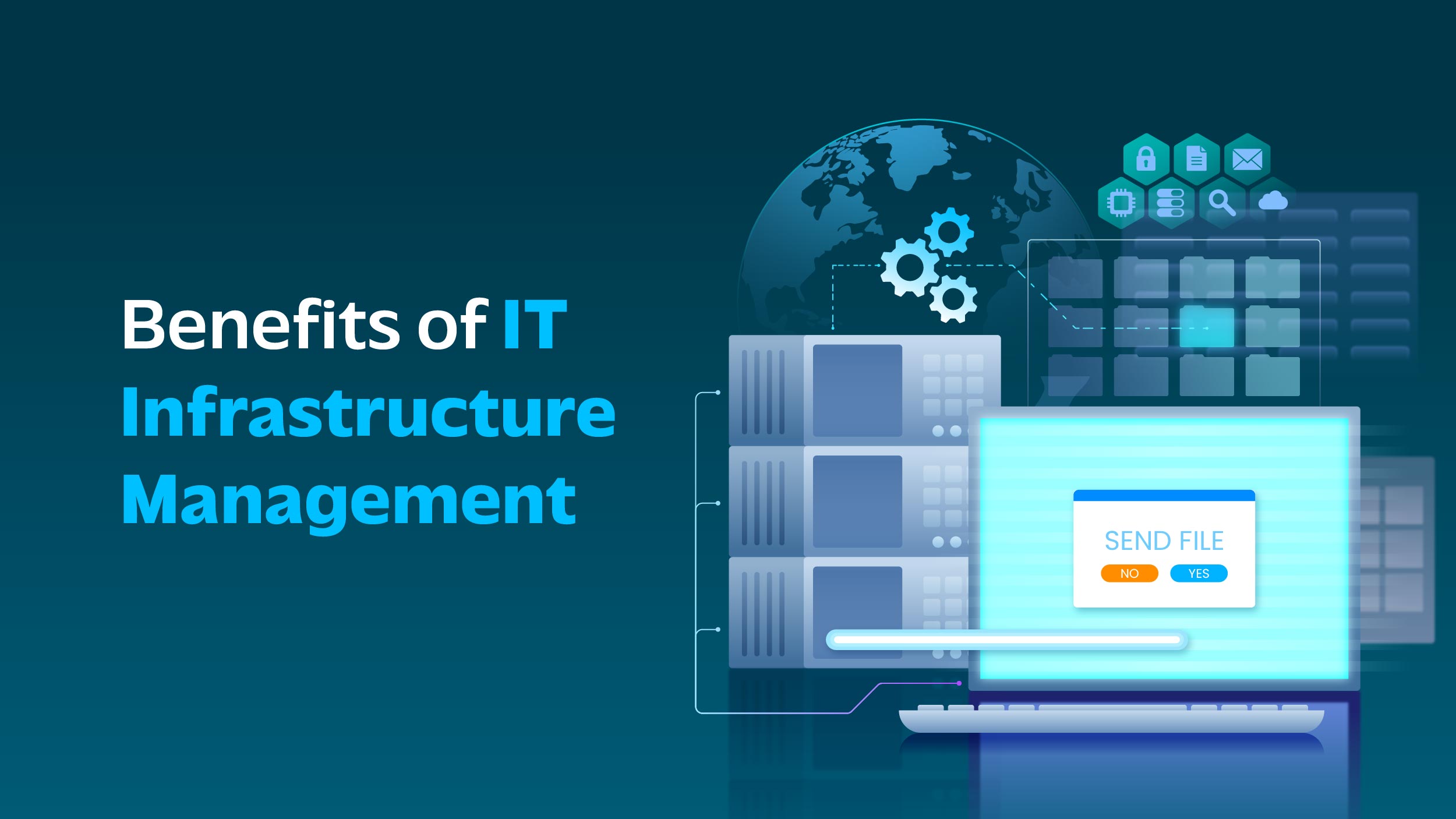IT infrastructure management is crucial for any organization. Imagine if you don’t have the right server, routers, and computers. What a mess that’ll be. This is exactly what infrastructures are: tiny yet important components of information technology (IT).
According to Statista, IT network infrastructure & equipment market is expected to hit a valuation of $199.2 billion. This billion-dollar industry makes up the technological components of a company’s IT systems.
What is Infrastructure Management?
Infrastructure management refers to the process of coordinating and maintaining an organization’s IT infrastructure, spanning hardware, data storage, operating systems, networks, enterprise software, and internet platforms, to ensure seamless operations. Though the concept seems straightforward, the array of tasks required to achieve this goal is extensive.
Broadly, infrastructure management can be categorized into three main areas:
- Storage Management: This entails activities such as backup and recovery, capacity planning, and monitoring storage performance.
- System Management: Tasks under this category include installing updates, monitoring system performance, and administering user accounts.
- Network Management: This involves configuring network devices, implementing firewalls, monitoring network traffic, and troubleshooting connectivity issues.
IT managers oversee the setup, maintenance, and resolution of issues related to six primary categories of systems:
- Data storage
- Internet platforms
- Operating systems
- Hardware platforms
- Enterprise software
- Networks and communications
Benefits of IT Infrastructure Management

IT infrastructure management encompasses the supervision of crucial IT infrastructure elements necessary for delivering business services. These elements can range from software applications to networking components, with a primary emphasis on physical components like computer and networking hardware, as well as the facility itself. The advantages of effective IT infrastructure management translate into financial and operational savings, including:
- Enhanced responsiveness to operational changes, emergencies, and other disruptive situations.
- Implementation of proactive measures through agile processes.
- Decreased financial expenses through automation and improved capacity planning.
- Optimization of employee operations and roles to enhance work efficiency.
- Minimization of integration challenges and system downtime.
Strategies for IT Infrastructure Management
Aligning with Business Objectives
Effective IT infrastructure management involves aligning technology management with business strategy to create value for the entire organization.
Proactive Management
Implementing flexible and agile procedures leads to proactive management strategies rather than reactive ones.
Streamlining Operations
Streamlining day-to-day functions and operations will free up time for personnel, allowing them to better plan and meet the demands of the overall business strategy.
Enhancing Customer Satisfaction
Improved customer satisfaction and overall performance through reduced downtime, accelerated deployments, and decreased repair time.
Evaluating and Planning
Evaluating the existing infrastructure and clearly outlining the organization’s goals to create a comprehensive strategy that addresses areas such as asset management, network infrastructure, data center operations, and cloud migration.
Increasing Agility
Enabling agility and cost optimization by embracing rapidly evolving strategies and technologies such as hybrid cloud, hyper-converged infrastructure (HCI), and software-defined networking (SDN).
Optimizing Processes
Optimizing processes, embracing digital transformation trends, and incorporating advancements in APIs, cloud infrastructures, and optimization strategies into the IT landscape.
Maintaining Compliance and Network Security
Ensuring compliance with IT standards and regulations, maintaining effective change management, and reducing overall IT costs while ensuring data security and privacy.
These strategies help organizations efficiently manage their IT resources, enhance operational efficiency, and align technology with business goals. It is important to note that IT infrastructure management strategies may vary depending on the specific needs and objectives of each organization.
What is the Role of an IT Infrastructure Manager?

An infrastructure manager’s duties vary depending on factors such as the organization’s network size and structure. However, there are 5 responsibilities encountered by all IT managers:
- System Security: Ensuring the security of the infrastructure involves tasks such as installing antivirus software, configuring firewalls, enforcing password policies, encrypting sensitive data, and monitoring alerts. Automation of cybersecurity processes can aid in managing these tasks efficiently, such as automating document encryption through platforms like AnonyFlow.
- Standards and Procedures (S&P): The IT manager establishes and implements processes to ensure the effective utilization of the company’s IT resources. This includes training employees and enforcing IT maintenance and security procedures.
- Performance Monitoring: Monitoring the performance of IT systems involves tracking key performance indicators (KPIs) such as outage frequency, mean time to resolve, storage utilization, and network performance metrics like upload and download speeds and network latency.
- Documentation and Reporting: Rigorous documentation is essential for tracking infrastructure performance and enforcing IT standards. The IT manager is responsible for creating training materials, maintaining system logs, tracking and reporting system performance, and documenting security incidents or breaches.
- Systems Development: Creating new systems to address evolving needs is also a responsibility of IT managers, particularly in large organizations or those handling sensitive data. This involves following a detailed process for implementing new tools and technologies.
Also Read: 6 Best Digital Banking Trends You Should Know in 2024
Types of Infrastructure
The IT infrastructure encompasses two primary types: traditional and cloud infrastructure.
Traditional Infrastructure
This includes typical hardware and software elements like as servers, data centers, desktop computers, networking hardware, facilities, and corporate application software. Compared to other forms of infrastructure, this configuration usually requires a significant amount of electricity, physical area, and financial investment. Conventional infrastructure is typically set up on-site for private or exclusive company use.
Cloud Infrastructure
Cloud computing IT infrastructure shares similarities with traditional infrastructure. However, end users gain access to the infrastructure via the internet, allowing them to utilize computing resources without the need for on-premises installation through virtualization. Virtualization connects physical servers maintained by a service provider across various geographical locations. These servers are then partitioned and abstracted to render resources, such as storage, accessible to users from almost any location with an internet connection. Since cloud infrastructure is frequently public, it is often referred to as a public cloud.
What are the Three Main Categories of IT Infrastructure?
Systems Management
Systems management encompasses a broad spectrum of essential activities within the overarching framework of IT infrastructure management. It involves administering all IT assets typically housed within a data center. A Chief Information Officer (CIO) or Chief Technical Officer (CTO) typically oversees the day-to-day operations of the data center and manages the integration of new applications and third-party services into the organization’s hybrid cloud environment.
Systems management encompasses a variety of activities, including workload automation, configuration management, log management, cloud application and service integration, and security-focused projects like intrusion detection and prevention.
Network Management
Network management focuses on the effective administration of secure networks. IT security and operations analysts are responsible for configuring and managing networks to ensure appropriate resource allocation to applications and services while maintaining service quality and availability.
Additionally, network management includes a security component, whereby IT operators maintain visibility and transparency into the network to uphold the organization’s security posture and safeguard against unauthorized access and data breaches.
Storage Management
Given that data storage space is a finite and valuable resource for IT and business organizations, overseeing data storage technologies and resources is a critical facet of IT infrastructure management. Storage management encompasses tasks such as virtualization, storage provisioning, data compression, and data security.
Techniques like data compression and automatic storage provisioning can enhance data processing times and optimize data center performance. Automation and virtualization enable businesses to dynamically reallocate storage resources as needed. Moreover, management techniques such as data replication, mirroring, and security measures help mitigate the risks of data loss or theft.
Final Thoughts
Effective IT infrastructure management is a critical component of any organization’s success in today’s technology-driven world. By aligning technology management with business objectives, streamlining operations, and embracing proactive strategies, businesses can enhance customer satisfaction, improve operational efficiency, and drive overall performance.




